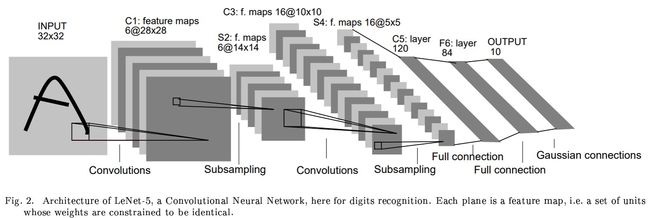MNIST手写数字识别 —— Lenet-5首个商用级别卷积神经网络
MNIST数据集之所以成为深度学习入门的数据集,是因为LeNet-5网络的诞生,该网络的手写数字识别效果能达到商用水平,是第一个真正意义上达到商用的深度神经网络,广泛应用于手写支票的识别。
卷积神经网络多应用于图像分类任务中,其采用分层的结构对图片进行特征提取,由一系列的网络层堆叠而成,比如卷积层、池化层、激活层等等。
本案例将使用Lenet-5来实现手写数字识别。
1. 加载并处理数据集
由于卷积神经网络训练时对显存的要求更大,无法将整个数字识别的6万个样本一次性载入训练,因此需要分批加载训练集进行训练。
import os
import sys
import moxing as mox
datasets_dir = '../datasets'
if not os.path.exists(datasets_dir):
os.makedirs(datasets_dir)
if not os.path.exists(os.path.join(datasets_dir, 'MNIST_Data.zip')):
mox.file.copy('obs://modelarts-labs-bj4-v2/course/hwc_edu/python_module_framework/datasets/mindspore_data/MNIST_Data.zip',
os.path.join(datasets_dir, 'MNIST_Data.zip'))
os.system('cd %s; unzip MNIST_Data.zip' % (datasets_dir))
sys.path.insert(0, os.path.join(os.getcwd(), '../datasets/MNIST_Data'))
from load_data_all import load_data_all
from process_dataset import process_dataset
mnist_ds_train, mnist_ds_test, train_len, test_len = load_data_all(datasets_dir) # 加载数据集
mnist_ds_train = process_dataset(mnist_ds_train, batch_size= 32, resize= 32) # 处理训练集,分批加载
mnist_ds_test = process_dataset(mnist_ds_test, batch_size= 32, resize= 32) # 处理测试集,分批加载训练集规模:60000,测试集规模:10000
2. 构建LeNet-5网络和评价函数
LeNet-5有5层网络,分别是卷积层1、卷积层2、全连接层1、全连接层2、全连接层3,网络结构如下图所示:
import mindspore
import mindspore.nn as nn
import mindspore.ops as ops
from mindspore.common.initializer import Normal
class Network(nn.Cell):
"""Lenet network structure."""
# define the operator required
def __init__(self, num_class=10, num_channel=1):
super(Network, self).__init__()
self.conv1 = nn.Conv2d(num_channel, 6, 5, pad_mode='valid')
self.conv2 = nn.Conv2d(6, 16, 5, pad_mode='valid')
self.fc1 = nn.Dense(16 * 5 * 5, 120, weight_init=Normal(0.02))
self.fc2 = nn.Dense(120, 84, weight_init=Normal(0.02))
self.fc3 = nn.Dense(84, num_class, weight_init=Normal(0.02))
self.relu = nn.ReLU()
self.max_pool2d = nn.MaxPool2d(kernel_size=2, stride=2)
self.flatten = nn.Flatten() # 输入到全连接层之前需要将16个5*5大小的特性矩阵拉成一个一维向量
# use the preceding operators to construct networks
def construct(self, x):
x = self.max_pool2d(self.relu(self.conv1(x)))
x = self.max_pool2d(self.relu(self.conv2(x)))
x = self.flatten(x)
x = self.relu(self.fc1(x))
x = self.relu(self.fc2(x))
x = self.fc3(x)
return x
def evaluate(pred_y, true_y):
pred_labels = ops.Argmax(output_type=mindspore.int32)(pred_y)
correct_num = (pred_labels == true_y).asnumpy().sum().item()
return correct_num3. 定义交叉熵损失函数和优化器
# 损失函数
net_loss = nn.SoftmaxCrossEntropyWithLogits(sparse=True, reduction='mean')
# 创建网络
network = Network(28*28)
lr = 0.01
momentum = 0.9
# 优化器
net_opt = nn.Momentum(network.trainable_params(), lr, momentum)4. 实现训练函数
def train(network, mnist_ds_train, max_epochs= 50):
net = WithLossCell(network, net_loss)
net = TrainOneStepCell(net, net_opt)
network.set_train()
for epoch in range(1, max_epochs + 1):
train_correct_num = 0.0
test_correct_num = 0.0
for inputs_train in mnist_ds_train:
output = net(*inputs_train)
train_x = inputs_train[0]
train_y = inputs_train[1]
pred_y_train = network.construct(train_x) # 前向传播
train_correct_num += evaluate(pred_y_train, train_y)
train_acc = float(train_correct_num) / train_len
for inputs_test in mnist_ds_test:
test_x = inputs_test[0]
test_y = inputs_test[1]
pred_y_test = network.construct(test_x)
test_correct_num += evaluate(pred_y_test, test_y)
test_acc = float(test_correct_num) / test_len
if (epoch == 1) or (epoch % 10 == 0):
print("epoch: {0}/{1}, train_losses: {2:.4f}, tain_acc: {3:.4f}, test_acc: {4:.4f}".format(epoch, max_epochs, output.asnumpy(), train_acc, test_acc, cflush=True))5. 配置运行信息
from mindspore import context
context.set_context(mode=context.GRAPH_MODE, device_target="GPU") # device_target 可选 CPU/GPU, 当选择GPU时mindspore规格也需要切换到GPU6. 开始训练
训练50个epoch,耗时约11分钟
import time
from mindspore.nn import WithLossCell, TrainOneStepCell
max_epochs = 50
start_time = time.time()
print("*"*10 + "开始训练" + "*"*10)
train(network, mnist_ds_train, max_epochs= max_epochs)
print("*"*10 + "训练完成" + "*"*10)
cost_time = round(time.time() - start_time, 1)
print("训练总耗时: %.1f s" % cost_time)**********开始训练********** epoch: 1/50, train_losses: 2.3162, tain_acc: 0.1095, test_acc: 0.1027 epoch: 10/50, train_losses: 0.0008, tain_acc: 0.9942, test_acc: 0.9846 epoch: 20/50, train_losses: 0.0001, tain_acc: 0.9984, test_acc: 0.9832 epoch: 30/50, train_losses: 0.1701, tain_acc: 0.9996, test_acc: 0.9839 epoch: 40/50, train_losses: 0.0000, tain_acc: 1.0000, test_acc: 0.9861 epoch: 50/50, train_losses: 0.0000, tain_acc: 1.0000, test_acc: 0.9864 **********训练完成********** 训练总耗时: 686.4 s
可以看到,使用LeNet-5网络训练11分钟,50个epoch后,测试准确率达到98.6%
